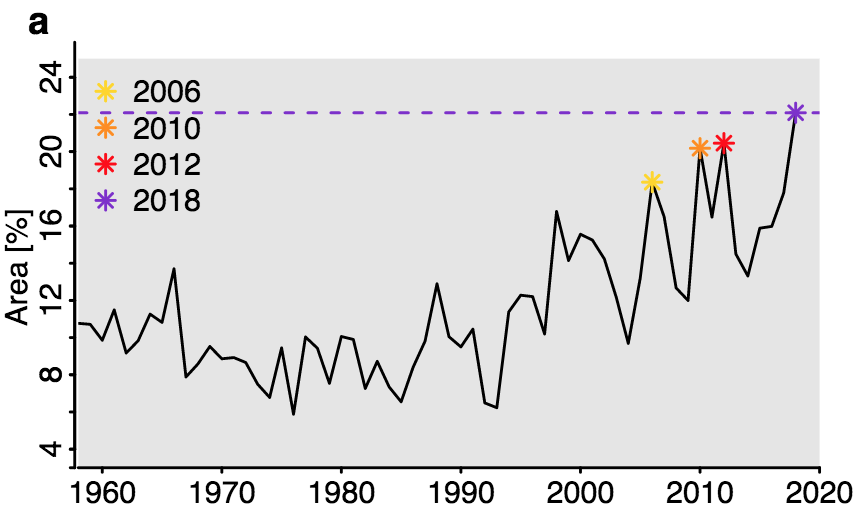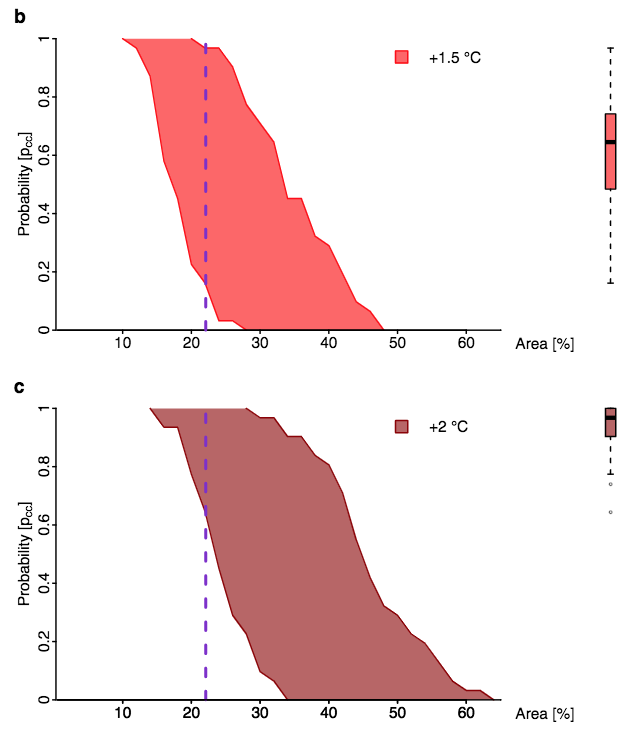
Northern hemisphere’s extreme heatwave in 2018 ‘impossible’ without climate change
Daisy Dunne
06.12.19Daisy Dunne
12.06.2019 | 10:58amLast summer’s unprecedented northern-hemisphere heatwave “could not have occurred without human-induced climate change”, a new study concludes.
Scientists are “virtually certain” that the three-month event – which saw temperature records broken from Belfast to Montreal and wildfires in places such as the Arctic circle, Greece and California – could not have happened in a world without human-caused greenhouse gas emissions.
The study also finds that summer heatwaves on the scale of that seen in 2018 could occur every year if global temperatures reach 2C above pre-industrial levels. If global warming is limited to 1.5C – the international aspirational limit – such heatwaves could occur in two of every three years.
The findings mirror recent research suggesting that the extreme heat seen in Japan in 2018, in which more than 1,000 people died, could not have occurred without climate change.
Both studies are the latest in “attribution science”, a field that uses modern techniques to detect the “fingerprint” of climate change on extreme-weather events.
Summer scorcher
Last summer’s unprecedented northern-hemisphere heatwave dominated frontpages. The extreme heat lasted for months and broke temperature records simultaneously across North America, Europe and Asia.
Among its impacts, the heatwave caused crop failures across Europe, fanned wildfires from Manchester in the UK to Yosemite National Park in the US and exposed more than 34,000 people to power outages in Los Angeles as the grid experienced an unprecedented demand for air conditioning.
As the heat continued to wreak havoc at the end of July, scientists released a rapid assessment finding that climate change made the hot conditions seen in Europe up to five times more likely to occur.
This was followed later by preliminary analysis from the UK’s Met Office in December which found that the heat experienced by the UK was made up to 30 times more likely by climate change.
And, in May, a study found that the heatwave in Japan – one of the worst affected countries – could not have happened at all without human-caused global warming.
The new paper, published in the journal Earth’s Future, is the first to assess the extent to which climate change could have boosted the odds of a heatwave on the same scale of that seen in 2018 across the entire northern hemisphere.
The results reveal that last summer’s northern-hemisphere heatwave was “extraordinary”, says study lead author Dr Martha Vogel, a climate extremes researcher from ETH Zurich. She tells Carbon Brief:
“We find these 2018 northern-hemispheric concurrent heat events could not have occurred without human-induced climate change. We are now in a climate where large areas can be affected simultaneously by extreme temperatures.”
Finding a fingerprint
For the analysis, the scientists first had to get a picture of the overall scale of last summer’s heatwave.
Using temperature data, they found that, on average, 22% of the northern hemisphere experienced “extremely hot” days simultaneously from May to June.
(The authors only considered land that was either densely populated or used for agricultural production. “Extremely hot” days were considered to be days when temperatures exceeded the 90th percentile of daily temperatures from 1958-88.)
The chart below gives an idea how the average fraction of land experiencing extreme heat in the northern hemisphere from May to July has changed from 1958 to today. On the chart, stars pinpoint the four largest northern-hemisphere heatwave events on record.

The average fraction of land experiencing extreme heat in the northern hemisphere from May to July. (Only densely populated and agricultural land is considered.) Stars pinpoint the four largest northern-hemisphere heatwave events on record. Source: Vogel et al. (2019)
The researchers then used climate models to study how often heatwaves on this scale are expected to happen in today’s world and in a hypothetical world without climate change.
To do this, the researchers produced three sets of simulations. The first set of simulations mirrored the conditions of today’s climate, including the influence of human-caused climate change.
The second set of simulations mirrored conditions from 1958-88, a time when the world had already warmed by 0.28C, according to the researchers. The third set of simulations mirrored “pre-industrial” conditions, a time before human-caused global warming.
The researchers then studied the simulations to see how often heatwaves on the same scale to that seen in 2018 occur under the various climate conditions.
The findings show that heatwaves on the same scale as that seen in 2018 have around a one-in-six chance of occurring in today’s climate. In contrast, in the simulations from 1955-88, such heatwaves had no chance of occuring.
This led the researchers to conclude that it is “virtually certain” that the 2018 northern-hemisphere heatwave could not have happened without climate change. Vogel explains:
“‘Virtually certain’ means that the probability that the event could have only occurred due to climate change is more than 99%.”
The language reflects the uncertainty guide used by the Intergovernmental Panel on Climate Change (IPCC).
Furnace forecast
The researchers also used climate models to make projections about the likelihood of heatwaves on the same scale as 2018 or larger occurring under a range of temperature scenarios.
They found that, if global temperatures are limited to 1.5C, such heatwaves could occur in around two of every three years – or a 65% probability of occurring in any one year. If temperatures reach 2C, such heatwaves could occur every year (97% probability).
This is demonstrated on the charts below, which show the probability of heatwaves on the same spatial scale to that seen in 2018 or larger occurring in the northern hemisphere under 1.5C (top) and 2C (bottom). On the chart, the dashed line shows the spatial scale of the 2018 northern-hemisphere heatwave.

The probability, in a given year, of heatwaves on the same spatial scale to that seen in 2018 or larger occurring in the northern hemisphere under 1.5C (top) and 2C (bottom) of global warming. The dashed line shows the spatial scale of the 2018 northern-hemisphere heatwave. The box plot shows the average probability under each temperature and she spread of results. Source: Vogel et al. (2019)
The findings reinforce the need to strengthen efforts to meet the 1.5C target, Vogel says:
“If heatwaves occur in densely populated regions, this will have strong impacts on human health – particularly in regions where the expanding concurrent hot-days area is compounded by population increases. Hence, strong mitigation efforts are required to avoid future simultaneous heat-related impacts.”
The research represents “an important” step forward in our understanding of how climate change impacted last year’s northern-hemisphere heatwave, says Prof Peter Stott, a leading attribution scientist from the Met Office Hadley Centre, who was not involved in the study. He tells Carbon Brief:
“The authors come to the striking conclusion that we have entered a new climate regime in which the occurrence of extraordinary global-scale heatwaves cannot be explained without human-induced climate change. This finding is consistent with many other studies also reporting a rapidly escalating risk of such hot extremes.”
Vogel, M. M. et al. (2019) Concurrent 2018 hot extremes across Northern Hemisphere due to human-induced climate change, Earth’s Future, https://doi.org/10.1029/2019EF001189
-
Northern hemisphere’s extreme heatwave in 2018 ‘impossible’ without climate change

